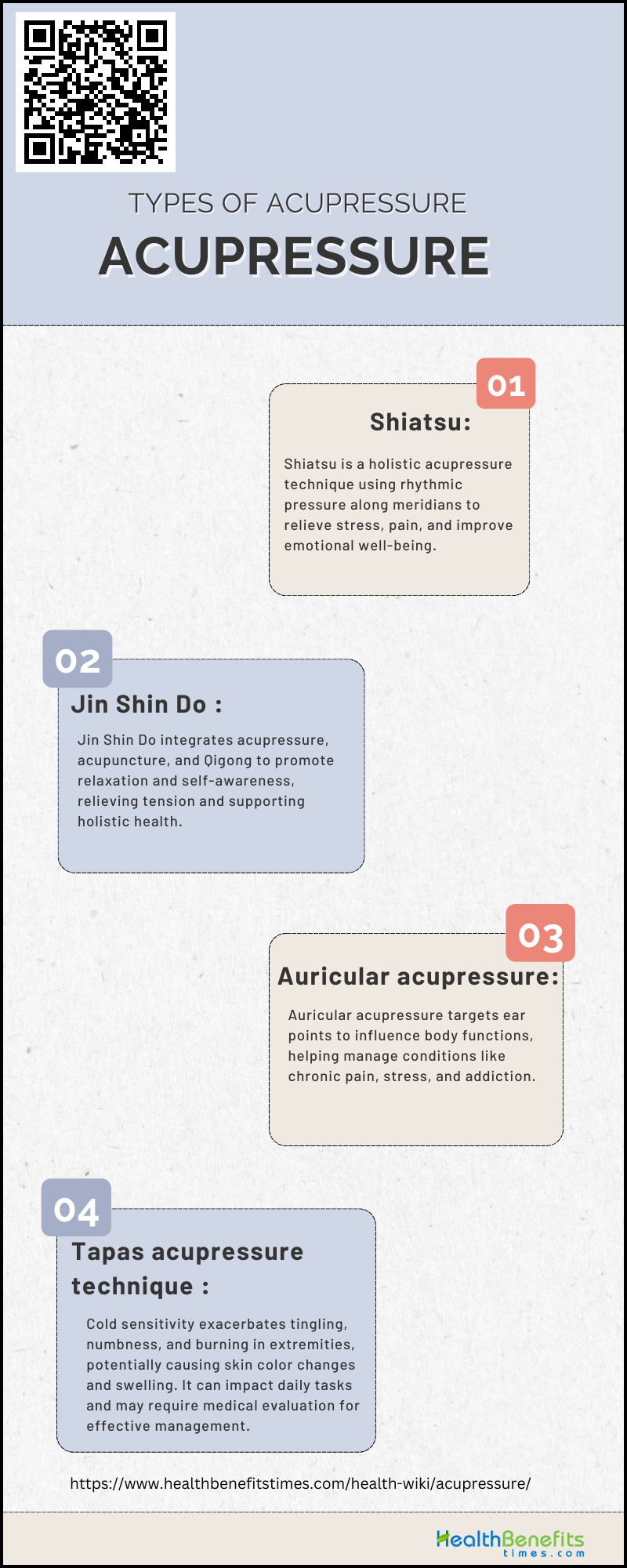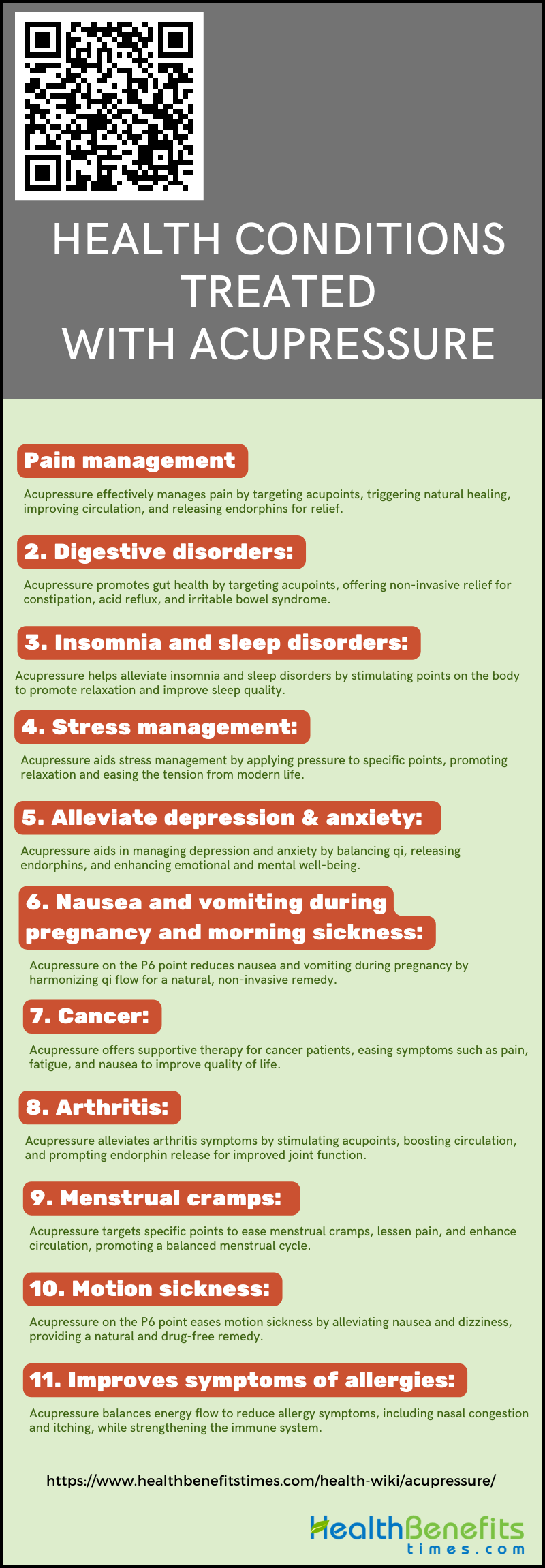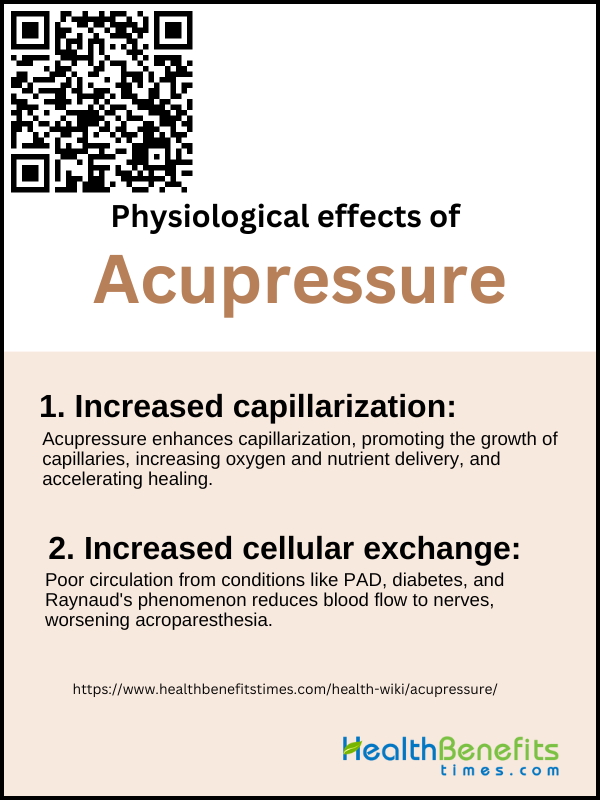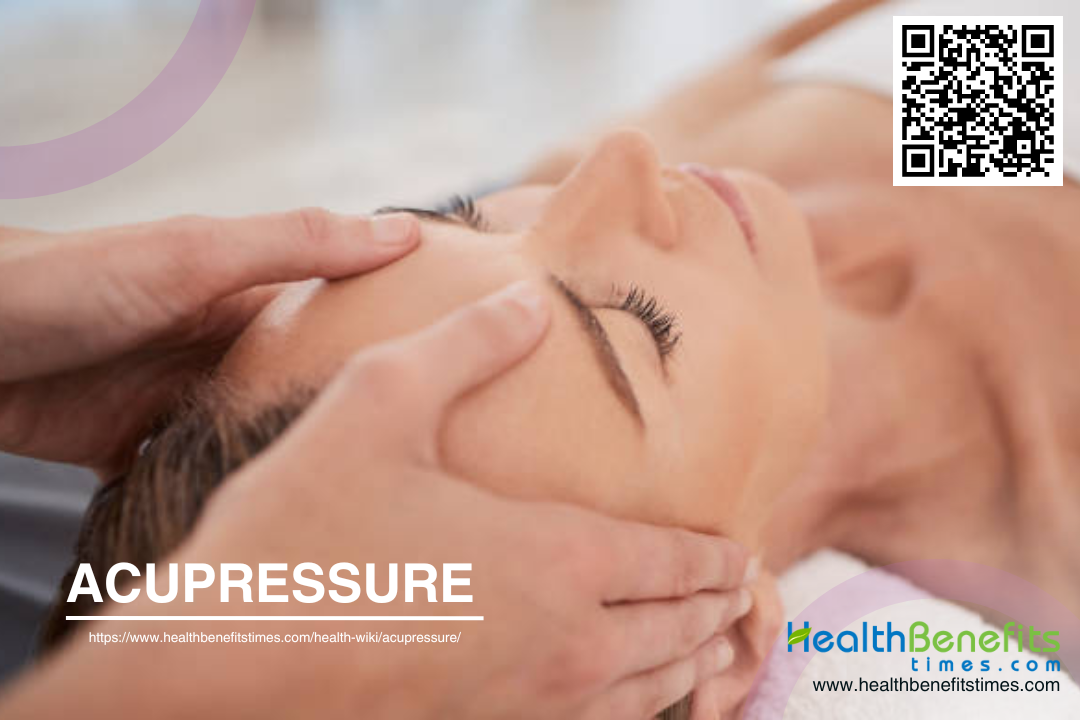Acupressure is an ancient healing technique from Traditional Chinese Medicine that involves applying pressure to specific acupoints along the body’s meridians to enhance natural self-healing processes. By stimulating these points, acupressure promotes relaxation, improves circulation, and reduces tension, ultimately supporting overall well-being. This non-invasive, complementary therapy is known for its ability to alleviate various health issues like stress, headaches, and chronic pain without the use of medication. It is in line with holistic health principles, combining traditional wisdom with modern health practices to promote vitality and balance.
Principles of Acupressure
Acupressure is a traditional Chinese healing technique based on the concept of Qi, or life energy, flowing through meridians in the body. By applying pressure to specific acupoints using fingers, palms, elbows, or tools, acupressure aims to rebalance the flow of Qi, promoting overall well-being. This technique is known for its ability to reduce pain, alleviate stress, improve circulation, boost immune function, and enhance overall health. It combines ancient wisdom with modern knowledge, including elements of Western psychology, to provide a comprehensive, non-invasive approach to healing. Practicing acupressure can empower individuals to establish a harmonious connection between mind and body, leading to a holistic approach to wellness.
Types of Acupressure
This non-invasive therapy, which aims to harmonize the body’s energy flow, is available in various forms, each providing specific benefits customized to individual health needs and preferences. By exploring the established techniques of acupressure, we discover a cohesive approach to improving vitality and achieving a state of balance.
1. Shiatsu (Japanese Acupressure)
According to article, Shiatsu is a holistic acupressure therapy that is gaining recognition for its ability to alleviate a variety of health issues through a non-invasive technique. Known for its ability to induce relaxation and restore energetic balance, Shiatsu involves applying rhythmic pressure along the body’s meridians, which are pathways important for vital energy, or ‘qi’. By targeting these meridians using thumbs, fingers, and palms, as well as incorporating stretches and manipulative movements, this practice enhances the body’s natural healing abilities. Research has shown that Shiatsu can improve sleep, behavior, and emotional well-being, especially in children with psychiatric needs, and can help reduce symptoms of stress, chronic pain, and various disorders. Shiatsu’s unique approach, which does not involve oils and is performed over clothing, makes it a distinctive and accessible complement to traditional healthcare, embodying the principles of holistic health and wellness.
2. Jin Shin Do’s (Body Mind Acupressure)
According to article, Jin Shin Do, also known as Body Mind Acupressure, is a healing practice that combines traditional Japanese acupressure, classic Chinese acupuncture, Taoist philosophy, Qigong, and Western psychology to harmonize the body and mind. Developed in the 1970s by psychotherapist Iona Marsaa Teeguarden, this holistic technique promotes relaxation, self-awareness, and pain relief. By applying pressure to specific acupoints, Jin Shin Do releases energy blockages along the meridians, enhancing the body’s natural healing abilities and promoting balance. This comprehensive approach to health emphasizes the emotional aspects of well-being, integrating the mind, body, and spirit for those seeking wellness.
3. Auricular acupressure (AA)
Auricular acupressure (AA) is a non-invasive therapy rooted in Traditional Chinese Medicine that targets specific points on the ear, considered a microsystem of the body, to promote overall health and well-being. By applying pressure using seeds, beads, or magnets, AA can influence the body’s internal organs and functions, providing a simple yet effective way for individuals to manage a variety of conditions such as chronic pain, stress, addiction, and hormonal imbalances. Its ease of use and compatibility with conventional medical treatments make AA a valuable component of a wellness-oriented regimen, highlighting its importance on a holistic health and fitness website.
4. Tapas acupressure technique (TAT)
The Tapas Acupressure Technique (TAT), developed by licensed acupuncturist Tapas Fleming, is a gentle yet transformative healing approach within the realm of holistic health. By placing fingers on specific energy points on the head and focusing on healing statements, TAT aids in dissipating negative emotions and physical stress, fostering relaxation and reducing pain. This non-invasive practice, which does not require deep physical pressure, is sought for its ability to alleviate anxiety, phobias, and post-traumatic stress, thereby promoting emotional and physical balance. Its simplicity and effectiveness have made TAT a revered method in wellness communities for those in pursuit of inner peace and improved well-being.
Common Acupuncture Points
Acupuncture is also a traditional therapeutic techniques that originated from Traditional Chinese Medicine. It aims to restore the body’s natural balance and promote healing by stimulating specific points. This description explores the most commonly used acupuncture points, revealing their unique functions and potential to improve overall health and vitality. With a history dating back thousands of years, these points play a crucial role in regulating the body’s energy flow, providing a pathway to improved well-being and a harmonious balance of the body’s complex systems.
- He Gu (LI-4)
- Liver 3 (LR-3)
- Spleen 6 (SP-6)
- Lie Que (LU-7)
- Qu Chi (LI-11)
- Zu San Li (ST-36)
- Shen Shu (UB-23)
- Liang Qiu (ST-34)
- P-6 (Neiguan)
- ST-25 (Tianshu)
- LV-3 (Taichong)
- Ren-6 (Qihai)
- EX-HN3 (Yintang)
- LI-20 (Yingxiang)
Different Acupressure Tools and Techniques
Utilizing the traditional knowledge of Traditional Chinese Medicine, acupressure provides a non-invasive method to relieve pain and enhance overall well-being by focusing on specific points on the body. This ancient healing technique is becoming increasingly popular in holistic health circles, due to a variety of tools and methods designed for both personal and professional use. These widely accepted tools are improving the efficacy of the practice, giving individuals a dependable way to access their body’s innate healing capabilities and strive towards better health and vitality.
- Footboard
- Device for fingers
- Clamps
- Footwear
- Pen
- Spinal device
- Ring
- Device for ear
- Gloves
How Acupressure Works
Acupressure is a practice rooted in traditional Chinese medicine that utilizes touch to stimulate the body’s natural healing abilities. By applying pressure to specific points, known as acupoints, this non-invasive therapy promotes the flow of Qi, the body’s vital life force, which can help reduce muscular tension and improve blood circulation. Acupressure is known for its ability to alleviate pain, reduce stress, boost the immune system, and enhance overall health. With a history spanning over 5,000 years, this technique, similar to acupuncture but without needles, is particularly effective in lowering blood pressure, relieving headaches, and easing nausea during pregnancy. By gently but firmly activating specific meridian points on the body, acupressure offers a holistic approach to wellness, addressing a range of physical and emotional ailments while promoting balanced energy flow.
Health Conditions Treated with Acupressure
A non-invasive approach to addressing a variety of health conditions. By applying pressure to specific points on the body, this technique aims to restore balance and promote natural healing. Below is a list of ailments for which acupressure has been known to provide relief and promote wellness.
1. Pain management (headaches, back pain, etc.)
Acupressure is an ancient technique derived from Traditional Chinese Medicine that offers a holistic and non-invasive approach to pain management. By targeting specific acupoints on the body, it stimulates the body’s self-healing abilities, improves circulation, and releases endorphins, which are natural pain relievers. This method is particularly effective for individuals with chronic headaches, migraines, and lower back pain, as it alleviates muscle tension and promotes relaxation. Additionally, acupressure can address underlying causes of discomfort, such as spinal misalignments, making it a valuable complement to conventional therapies. Integrating acupressure into a regular wellness routine not only helps individuals manage their pain but also enhances their overall quality of life, embodying the principles of holistic health and well-being.
2. Digestive disorders
Acupressure, a traditional technique from Traditional Chinese Medicine, effectively treats a range of digestive disorders by targeting specific acupoints on the body’s meridians. This non-invasive method can alleviate conditions such as constipation, gastroesophageal reflux disease, and irritable bowel syndrome by stimulating the body’s self-healing mechanisms and improving energy flow. Its holistic approach provides a gentler alternative to pharmaceuticals, making it an attractive option for individuals seeking natural wellness solutions. However, it is important to consult a healthcare professional before incorporating acupressure into one’s health regimen to ensure it complements their overall strategy.
3. Insomnia and sleep disorders
Acupuncture, originating from Traditional Chinese Medicine, provides a non-invasive and effective treatment for insomnia and sleep disorders by stimulating specific points on the body to promote balance and relaxation. This holistic approach, which includes both acupuncture and acupressure, has been scientifically proven to improve sleep quality, reduce the severity of insomnia, and address associated symptoms such as stress, anxiety, and depression. By targeting the body’s natural energy flow, these therapies enhance self-healing abilities and increase melatonin production, resulting in improved sleep patterns and emotional well-being. As a result, they are increasingly popular within the holistic health, fitness, and wellness community for individuals seeking natural methods to achieve restful sleep.
4. Stress managements
According to article, Acupressure, a fundamental practice in Traditional Chinese Medicine, is an effective tool for managing stress by stimulating the body’s natural healing abilities. By applying pressure to specific acupoints, it activates the flow of energy known as “qi,” promoting relaxation and reducing tension associated with today’s fast-paced lifestyle. This technique helps to balance the body’s energy pathways and decrease stress hormones such as cortisol and adrenaline, resulting in a sense of calm and well-being. Acupressure is a non-invasive, drug-free option that allows individuals to actively participate in their holistic health journey, providing relief from anxiety, insomnia, headaches, and the overall stress of modern life.
5. Alleviate Depression & Anxiety
Acupressure is a healing practice based on Traditional Chinese Medicine that aims to improve mental health, especially in individuals with depression and anxiety. By applying pressure to specific acupoints on the body, this non-invasive technique seeks to balance the flow of qi, or life energy, and promote the body’s natural healing processes. Scientific studies, such as those conducted by Li et al., have shown that acupressure can impact neural plasticity and aid in recovery in the prefrontal cortex, which is important for emotional regulation. Regular acupressure sessions have been found to relieve muscle tension, increase circulation, enhance mood by releasing endorphins, and reduce anxiety. This complementary therapy can support emotional and mental well-being.
6. Nausea and vomiting during pregnancy and morning sickness
The gentle touch of acupressure on the Nei Guan (P6) point, located on the inner forearm near the wrist, provides relief for expectant mothers experiencing morning sickness. This holistic technique reduces the frequency and severity of nausea and vomiting while promoting the body’s natural healing abilities by balancing the flow of Qi, our vital life energy. It is a non-invasive natural remedy that allows pregnant women to improve their well-being without relying on pharmaceuticals. It is important to consult a healthcare provider before starting any new treatment to ensure the safety of both mother and child. By incorporating acupressure into their wellness routine, mothers-to-be can better manage the challenges of early pregnancy and enjoy a healthier journey to motherhood.
7. Cancer
Acupressure, a traditional Chinese medicine technique, has been recognized as a supportive therapy that may improve the quality of life for cancer patients by alleviating symptoms such as depression, constipation, fatigue, nausea, and pain. Applying gentle pressure to acupoints such as Hegu (LI4), Zusanli (ST36), and Sanyinjiao (SP6), as well as specific points on the ear, can potentially enhance well-being by balancing the body’s energy flow, known as ‘qi’. While acupressure is not a cure for cancer, its non-invasive nature provides a comforting alternative to managing the challenging side effects of conventional treatments. It is important for patients to consult healthcare providers before incorporating acupressure into their treatment plan to ensure it is safely tailored to their individual health needs.
8. Arthritis
According to article, Arthritis, characterized by joint pain and stiffness, can significantly impact daily life. Acupressure, a key component of Traditional Chinese Medicine, offers a holistic approach to alleviating symptoms. By targeting specific acupoints on the ear, this non-invasive therapy can enhance circulation, reduce muscle tension, and stimulate the release of endorphins, the body’s natural pain relievers. Studies have shown that auricular acupressure may help reduce knee pain, decrease the need for pain medication, and enhance joint function in individuals with osteoarthritis. While not a cure, acupressure is recognized for its ability to improve mobility and reduce pain, making it a valuable complementary therapy for managing arthritis symptoms and promoting overall well-being.
9. Menstrual cramps
Menstrual cramps, known as dysmenorrhea, are a common source of discomfort for many women, often interfering with daily activities. Acupressure, a holistic non-pharmacological approach, offers relief by targeting specific acupoints, such as Xuehai (SP10) near the knee, Sanyinjiao (SP6) above the ankle, and Hegu (LI4) between the thumb and index finger. Applying gentle pressure to these areas, as well as the ‘Sea of Energy’ below the navel, can alleviate muscle tension and improve circulation, reducing pain and enhancing overall well-being. Regular acupressure treatments not only decrease the intensity of menstrual pain but also promote a more regular menstrual cycle, making it an effective and natural method for managing menstrual symptoms.
10. Motion sickness
Acupressure, a traditional healing practice, provides a calming touch for individuals suffering from motion sickness, a condition of the inner ear caused by movement. By applying pressure to the Nei Guan (P6) point on the inner forearm, a natural, drug-free method of relief can be accessed. This technique, originating from Traditional Chinese Medicine, is becoming increasingly popular in the holistic health community due to its simplicity, affordability, and lack of side effects, making it a preferred option for travelers. By targeting the vagus nerve, acupressure stimulates the body’s self-healing abilities, alleviating symptoms such as nausea and dizziness, allowing individuals to enjoy travel with a sense of balance and tranquility.
11. Improves Symptoms of Allergies
Acupressure, a traditional practice from Chinese medicine, provides a gentle and non-invasive approach to alleviating allergy symptoms and improving pediatric allergic rhinitis. By applying pressure to specific points on the body, this technique helps to balance the flow of energy, known as Qi, resulting in a significant reduction in nasal congestion, itching, and watery eyes, as well as improved sleep quality. As a natural method that triggers the release of endorphins, acupressure fights against histamines and boosts the immune system, making it an ideal component of a holistic health regimen for individuals looking for a medication-free option to manage sneezing, headaches, and other allergy-related discomforts, ultimately enhancing overall well-being.
Physiological effects of acupressure
Acupressure is a traditional Chinese medicine technique that stimulates specific points on the body to promote natural self-healing, improve circulation, reduce pain, and balance energy pathways. This can lead to increased relaxation and well-being. By applying pressure to these points, this non-invasive therapy can release tension, boost the immune system, and facilitate a harmonious flow of energy throughout the body, ultimately impacting overall physiology.
1. Increased capillarisation
According to article, Acupressure, a traditional technique from Chinese medicine, is known for stimulating the body’s self-healing mechanisms, particularly by enhancing capillarization. By targeting specific points on the body, it promotes the growth of capillaries, enriching cells with increased oxygen and essential nutrients while expediting the removal of metabolic byproducts. This process not only speeds up healing and reduces muscle tension but also improves tissue health, promoting overall vitality. For those interested in holistic wellness, acupressure provides a significant way to balance bodily functions and enhance their health journey.
2. Increased cellular exchange
Acupressure, a fundamental aspect of traditional Chinese medicine, is renowned for its ability to enhance cellular exchange and promote self-healing. This non-invasive technique stimulates the flow of qi, or life energy, through the body’s meridians, encouraging the release of endorphins, improving blood circulation, and alleviating muscle tension. By applying pressure to specific acupoints, acupressure facilitates the transport of oxygen and nutrients directly to the cells, while expelling metabolic waste, thereby aiding in detoxification and tissue repair. These effects are particularly beneficial in enhancing physical performance, reducing fatigue, and maintaining the body’s balance, making acupressure an essential practice in holistic health, fitness, and wellness routines.


